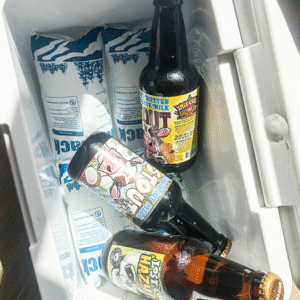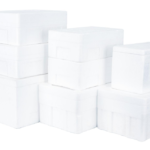How to Pack Dry Ice in a Cooler Safely (2025)
If you need frozen‑solid results, learning how to pack dry ice in a cooler the right way is essential. Pre‑chill, wrap blocks, add a barrier, pack tight, and vent safely. Do that and you’ll keep food frozen 24–72 hours, comply with the 2.5 kg airline limit, and avoid cracked lids or soggy messes. This guide merges and upgrades three drafts you provided into one 2025‑ready article.
-
How to pack dry ice in a cooler for 24–72 hours with a simple, repeatable method
-
How much dry ice you actually need by cooler size and trip length
-
How to pack dry ice in a cooler for flights under the 2.5 kg rule
-
How to pack dry ice in a cooler without freezing drinks using barriers and layout options
-
What to buy (blocks vs pellets) and how to avoid rapid loss and food burn
How to pack dry ice in a cooler for 24–72 hours?
Jawaban singkat: Pra -belukar pendingin, wrap dry ice blocks, add a cardboard/divider barrier, pack items tightly, and keep the package vented. Place dry ice on atas for the longest frozen hold (udara dingin tenggelam); put it under a barrier at the bottom if you want items chilled, tidak beku. Gloves and eye protection are non‑negotiable.
Why it works for you: Dry ice is –109 °F (–78.5 ° C.) and turns straight to gas (no melt water). Wrapping reduces surface loss, barriers protect liners and food, and tight packing cuts warm air pockets that “eat” your dry ice. A pre‑chilled cooler plus wrapped blocks can stretch performance from 24 up to ~72 hours depending on size, weather, and lid openings.
Layouts that simplify how to pack dry ice in a cooler
Top‑pack (max hold): Items → cardboard barrier → wrapped dry ice blocks → close lid
Bottom‑pack (easy access): Barrier → wrapped dry ice → barrier → items
Side‑pack (two zones): Divider with dry ice on one side; drinks/produce on the other
| Layout Option | Terbaik untuk | Watchouts | Apa artinya bagimu |
|---|---|---|---|
| Top‑pack | Longest frozen hold | Slightly less convenient access | Use for meat, ikan, ice cream on multi‑day trips |
| Bottom‑pack | Mixed “just cold” loads | Shorter frozen hold | Keeps snacks accessible; add water‑ice above barrier |
| Side‑pack | Split frozen/chilled | Needs a divider | Protects fillets while keeping drinks unfrozen |
Practical tips that save pounds of dry ice
-
Pre‑chill: Load with sacrificial ice overnight; dump it before packing dry ice.
-
Wrap & barrier: Newspaper/kraft wrap every block + corrugated sheet to protect liners.
-
Fill gaps: Towels or frozen bottles remove air pockets and slow sublimation.
-
Shade & shut: Keep out of sun; open the lid fast and rarely.
Kasus dunia nyata: A 55 qt hard cooler, pre‑chilled overnight with a cardboard barrier and a 10 lb top‑pack block, kept ice cream solid for ~36 hours at 88–92 °F with minimal openings.
How to pack dry ice in a cooler: how much do you need?
Aturan praktis: 5–10lb per 24 jam in a well‑insulated hard cooler. Scale up for larger coolers, high heat, frequent access, or flight altitude effects. Many field users plan ~10 lb per 15″ of interior length for deep‑freeze targets over 24–48 h.
Quick estimator (use it in 30 detik)
-
Trip length (hari -hari): D
-
Cooler class multiplier: Small = 1, Medium = 1.5, Large = 2, XL = 3
-
Base rate: 7.5 lb/24 h (midpoint of 5–10 lb)
-
Adjustments: +25% hot sun; +10% frequent access
Rumus: Pounds = D × 7.5 × Class × (1 + Adjustments)
Contoh: 48 H, Sedang, hot sun (+25%), frequent access (+10%) → 2 × 7.5 × 1.5 × 1.35 ≈ 30 lb.
Sizing table (frozen target)
| Cooler Size | 24 H | 48 H | Untukmu |
|---|---|---|---|
| Kecil (20–35 qt) | 5–10 lb | 10–20 lb | Overnight frozen snacks/meat |
| Sedang (45–65 qt) | 10–15 lb | 20–30 lb | Weekend camping; keep game/fish solid |
| Besar (75–110 qt) | 15–25 lb | 30–40 lb | Multi‑day hunts or outages |
| XL (150 qt+) | 25–40 lb | 50–80 lb | Extended runs; verify compatibility |
Estimates assume a hard, dry‑ice‑compatible cooler and tight packing.
How to pack dry ice in a cooler for flights (2025)?
Direct answer: ≤ 2.5 kg (5.5 lb) per passenger/package, kemasan ventilasi, and “Dry Ice/Carbon Dioxide, solid” marking with net weight. Seek airline approval before travel. Never tape the cooler airtight. Use gel packs to protect items when the dry ice is gone.
Checklist that passes acceptance:
-
Hard cooler that vents (gasket/drain cracked per maker guidance)
-
Label: “Dry Ice” (or “Carbon Dioxide, padat") + net mass (MISALNYA., “2.5 kg or less”)
-
Approval: Confirm with your carrier before check‑in
-
Layers: Wrap blocks + barrier + tight pack; minimal air space
-
Carry/Check: Orient to vent; avoid sealed trunks during ground legs
How to pack dry ice in a cooler without freezing drinks?
Barrier + placement + separation. Keep drinks on one side with water‑ice; put wrapped dry ice behind a divider atau on top with a barrier over fragile items. That gives you cold sodas without “freezer‑burn” spots on produce or cheese.
Block vs pellet: what should you buy?
-
Blok: Longest hold; fewer gaps; best for 48–72 h goals
-
Pellets/Nuggets: Faster pulldown; Isi kekosongan; great as a top‑up around blocks
-
“Airline cuts”: Pre‑sized packs to hit ≤ 2.5 kg when flying
Always wrap and add a barrier either way.
Dry ice vs. gel packs vs. regular ice (what’s right for you?)
| Method | Typical Temp | Lasts About* | Apa artinya bagimu |
|---|---|---|---|
| Es kering | –78.5 ° C. (–109 ° F.) | ~18–24 h per 5–10 lb | True frozen hold; no melt water; requires PPE & ventilasi |
| Paket gel | ≈ –18 °C to 0 °C | 12–24 h (size/insulation dependent) | Safer handling; dapat digunakan kembali; great for 2–8 °C |
| Regular ice | 0 ° C. (32 °F) | 4–18 h | Cheap, mudah; adds water weight and mess |
*Your results vary with insulation, sun, and how often you open the lid.
User‑friendly safety rules you can’t skip
-
Tidak pernah kedap udara: Gas buildup can bulge lids or rupture containers.
-
Ventilate vehicles and rooms: CO₂ is invisible and can displace oxygen; crack windows and avoid sealed trunks.
-
Wear insulated gloves and eye protection: Prevent frostbite and contact injuries.
-
Dispose in open air: Let leftover dry ice sublimate in a ventilated area—never in sinks or sealed trash.
2025 developments that change how to pack dry ice in a cooler
Apa yang baru: Reusable shippers, PCM (phase‑change materials) for 2–8 °C lanes, Dan IoT temperature loggers now complement dry ice. Teams mix Panel VIP + PCMS to shrink dry‑ice mass, cut waste, and monitor in real time. CO₂ supply dynamics still affect regional availability, so plan purchases ahead in peak seasons.
Latest at a glance
-
Reusable systems rising: Less EPS waste, lower long‑term cost
-
Smart monitoring: App‑connected loggers flag temperature drift early
-
VIP + PCM combos: Smaller packs, steadier temps, fewer excursions
Wawasan pasar: Expect steady growth in cold‑chain packaging and monitoring through the late 2020s. Untukmu, that means more options to combine dry ice with PCMs and loggers for greener, safer trips.
FAQ
How long does dry ice last in a cooler?
In a good hard cooler, plan 5–10 lb for ~24 h. Heat and frequent openings shorten that; pre‑chill and tight packing extend it.
Where should dry ice go—top or bottom?
Top for frozen results (wastafel dingin). Bottom under a barrier if you just want “cold, not frozen.”
Can I fly with dry ice in my cooler?
Yes—≤ 2.5 kg (5.5 lb) per passenger/package, ventilasi, labeled, and approved by the airline.
Will dry ice crack my cooler?
Use a dry‑ice‑rated hard cooler and add a barrier. Many soft coolers are not rated.
Is dry ice safe in a car?
Yes with ventilasi. Crack windows and avoid sealed cabins during long legs.
Actionable tools
2‑minute “Do I need dry ice?” self‑check
-
Goal frozen solid ≥24 h? If yes, Gunakan es kering; if no, use PCMs/gel packs.
-
Open lid ≥1×/hr? Add +10% es kering.
-
Hot sun > 90 °F? Add +25% dry ice and shade the cooler.
-
Mixed load? Side‑pack with a divider; minuman + water‑ice on the warm side.
Copy‑and‑use packing checklist (print for your lid)
-
Verify cooler is dry‑ice compatible
-
Pre‑chill 12–24 h
-
Rencana pound with the quick estimator
-
Wrap blocks + menambahkan barrier
-
Pack tight; fill all air gaps
-
Vent (crack drain/lid per maker)
-
Monitor temps (≤ 40 °F for food; ≤ 0 °F for frozen items)
-
Dispose safely in open air
Tentang tempk
We help teams move temperature‑sensitive goods safely and simply. Our reusable shippers, PCM packs, and connected loggers are validated to cut excursions and speed pack‑outs. Customers report fewer repacks Dan longer holds with our standard kits. Talk to us about a dry ice or PCM setup for your lanes—we’ll turn this guide into your SOP.
























